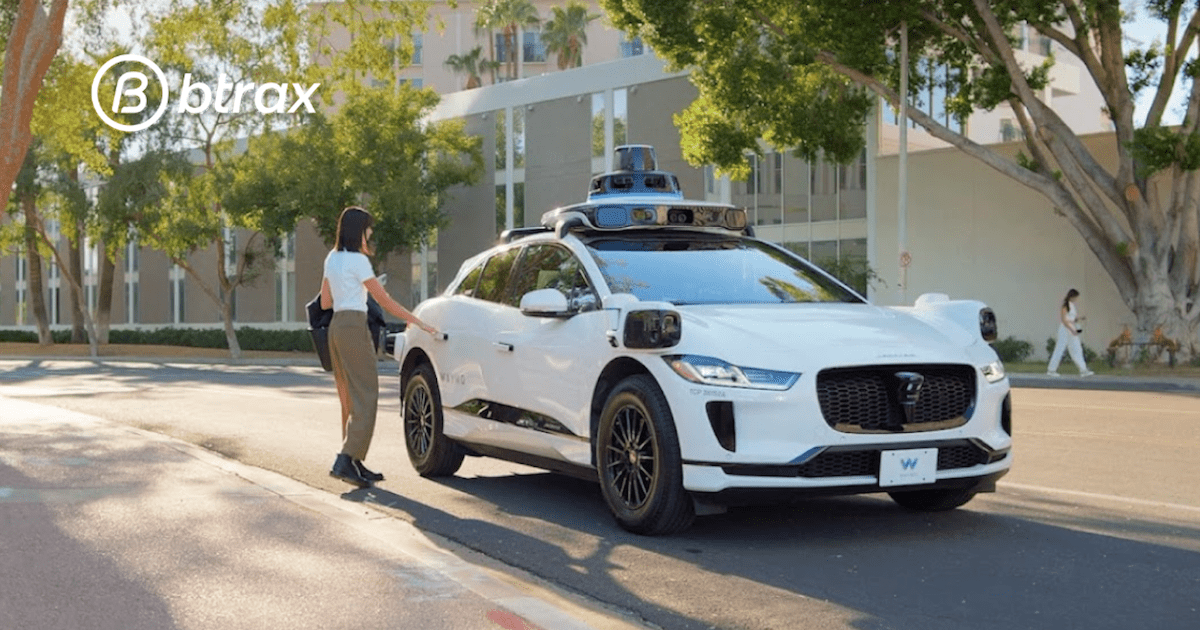
Btrax Design Company > Freshtrax > Riding into the...
Riding into the Future with Waymo’s Self-Driving Taxis
The future of transportation is here!
On August 10, 2023, California approved an all-day pay-as-you-go self-driving taxi service that has the city of San Francisco buzzing with excitement.
This new cab service will be completely driverless!
What’s the appeal of this service and the evolution of self-driving technology?
Let’s take a closer look at this new technology and its user experience.
What is a Driverless Taxi?
According to an article in TechTarget, “A self-driving car (sometimes called an autonomous car or driverless car) is a vehicle that uses a combination of sensors, cameras, radar and artificial intelligence (AI) to travel between destinations without a human operator.”
Companies such as Audi, BMW, Ford, Google, General Motors, Tesla, Volkswagen, and Volvo are some companies that have developed or tested self-driving cars.
As of January 2024, the leading self-driving taxi services in San Francisco are Waymo and Cruise.
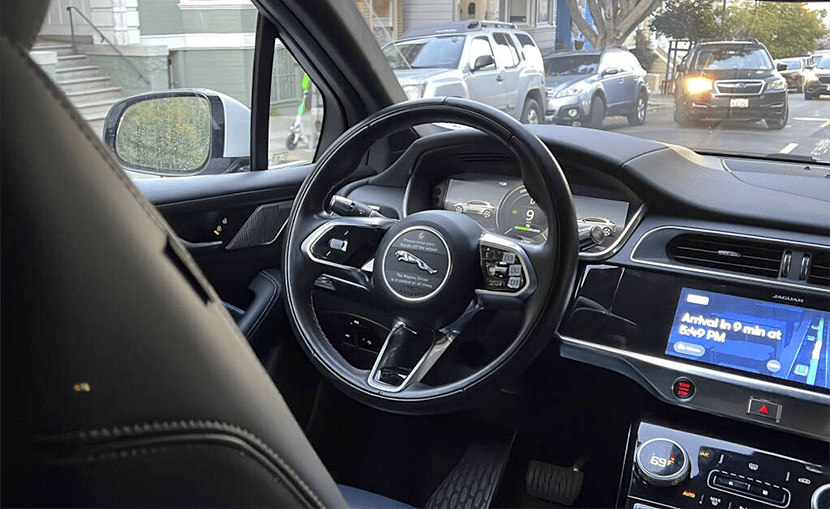
The unusual sight of an empty driver’s seat may soon become the norm
Waymo
Waymo, a self-driving technology company headquartered in Mountain View, CA, is a subsidiary of Google’s parent company, Alphabet, and began as Google’s self-driving car project in 2009.
The company operates a 24/7/365 fully self-driving cab service in San Francisco, Phoenix, and other areas.
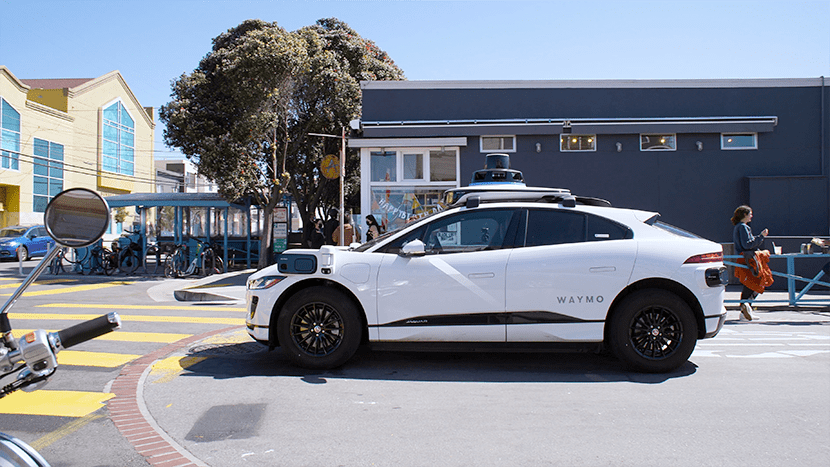
Jaguar I-PACE, the world’s first premium electric self-driving car
Cruise
Cruise is a self-driving car company headquartered in San Francisco, California and a subsidiary of General Motors. They have raised $9.25 billion (about 1.3 trillion yen) from investors such as SoftBank, Honda, and Microsoft to test and develop self-driving car technology.
Cruise cars have a 360-degree view of the road. Equipped with more than 40 sensors that provide 360-degree vision and can sense hundreds of feet away and even around a double-parked car.
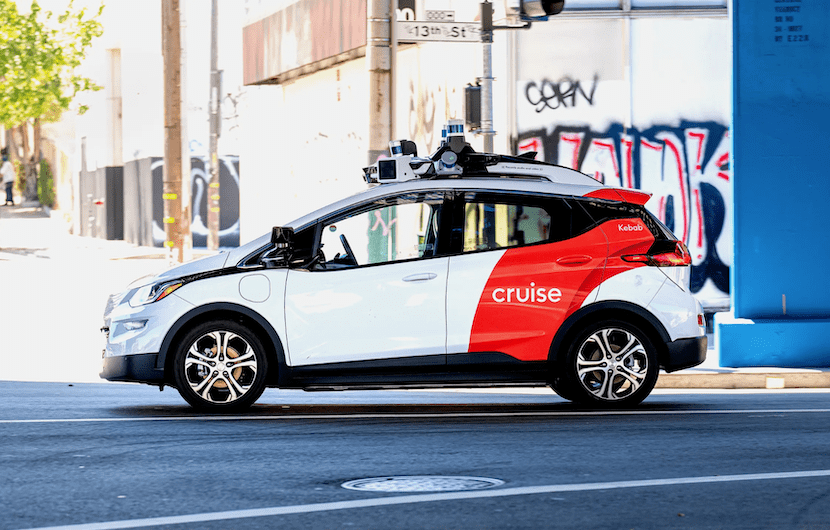
The Chevrolet Bolt EV modified for Cruise
Trying Waymo’s Driverless Taxi
I knew about the existence of driverless taxis before I came to San Francisco, so I immediately tried one the day after I arrived.
The experience was so unique and impressive.

What it looks like when your Waymo arrives
How to Use Driverless Taxi Services
The first and foremost thing that surprised me about using Waymo was the clarity and simplicity of the actions required from calling Waymo on the app to arriving at the destination.
Even though it was my first time using Waymo, I had no trouble using it.
All I had to do was to order a Waymo ride through the smartphone app, get on, and get off when I arrived at my destination.
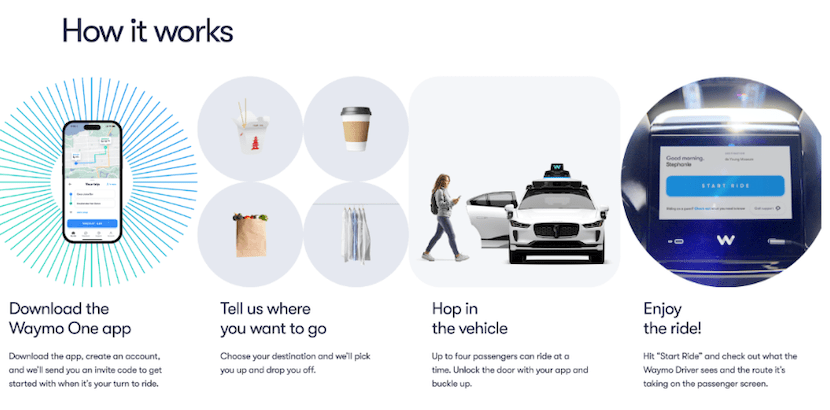
How to use Waymo
Adding Fun to Your Commute
As a fun addition, there were tablets like the one shown in the image in each of the front and rear seats. This allowed us to listen to whatever music we wanted to hear, check what route we were taking, and see how much time was left on the ride.
The tablets displayed people, cars, and motorcycles, so we could see what the Waymo sensors were detecting along the route.
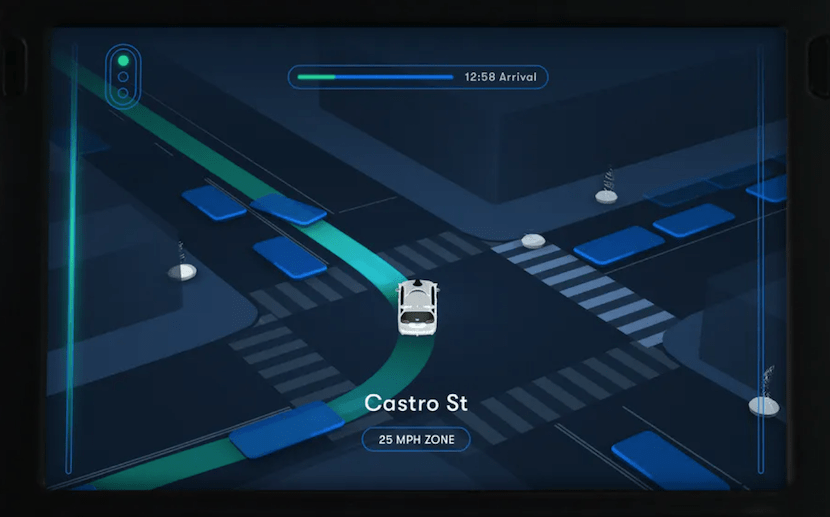
Waymo’s in-car tablet
Safety First
I was a bit concerned about what would happen if something went wrong since there was no driver to directly communicate with as there would be with an Uber or Lyft ride, but my fears were unnecessary.
If a problem should arise during the ride, there is a live support team that can be contacted via the tablet shown above.
Furthermore, if for some reason you need to get out early, you can press a button on the tablet to get off at a safe and nearby location.
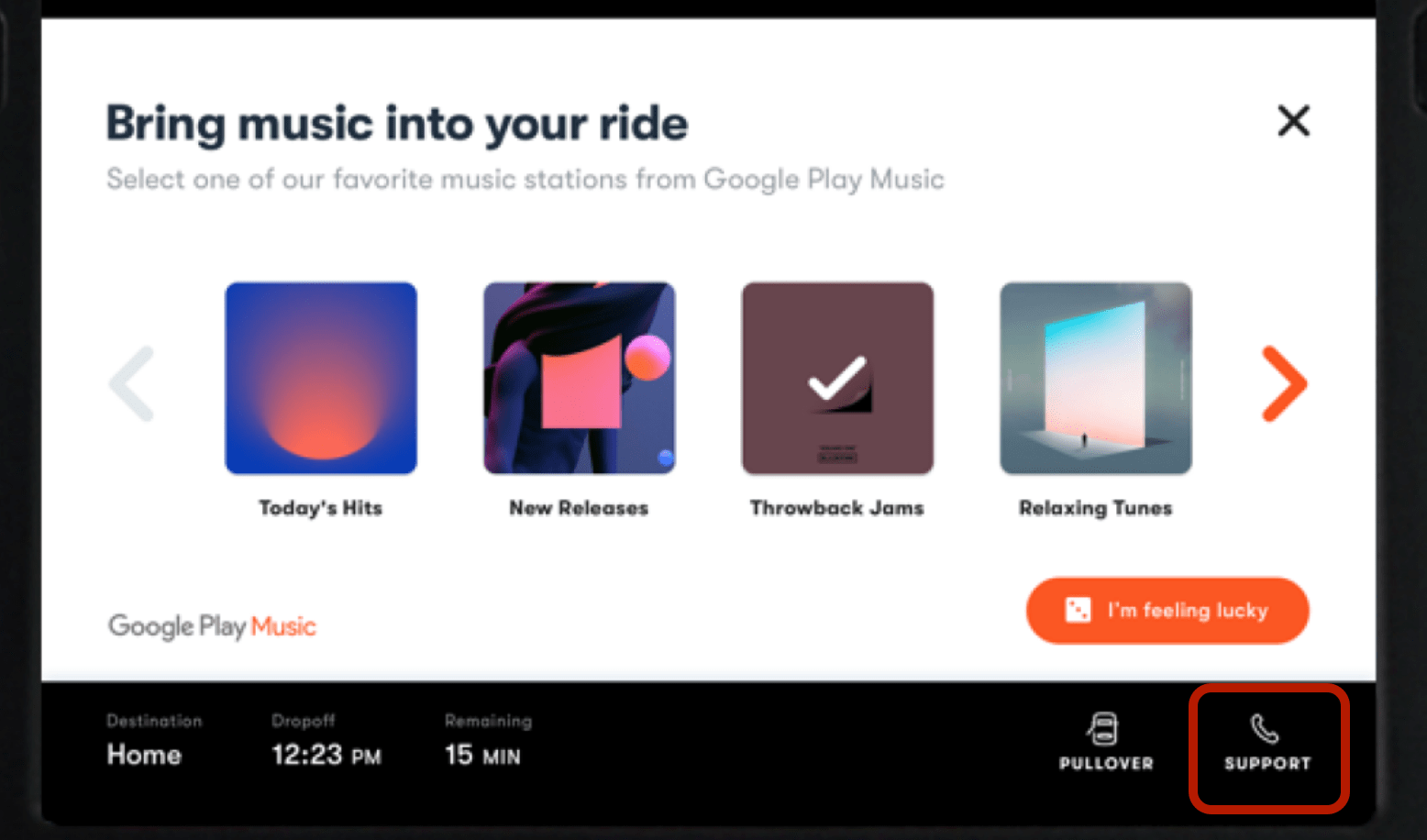
You can contact Waymo’s live support team via the button in the lower right corner of the tablet
The Peaceful Solitude of Driverless Taxis
I enjoyed the peaceful solitude of riding in a self-driving taxi.
Services such as Uber and Lyft are very convenient, however I sometimes struggle with the awkwardness of small-talk with a stranger. Especially early in the morning, it can be a lot of pressure to be cheerful and talkative. The tipping system is also a bit nerve-wracking at times.
I was so excited to use Waymo’s service! I was able to enjoy the ride with my friends and have our conversation without bothering anyone.

Seamless User Experience
My experience using Waymo was extremely smooth.
When I heard that a machine was driving, I was afraid that it might make some clumsy movements on its own. I was happy to see that it drove smoothly, making turns and stops effortlessly even in a major city like San Francisco, where there are many different kinds of roads and obstacles.
The car was also able to pull over and choose a spot where I could safely enter and exit the vehicle, it seemed so intelligent.
To make it even better, the Waymo managed to arrive 3 minutes earlier than the estimated time, which had been provided at the beginning of our journey.
Surprisingly Inexpensive
I wanted to see how Waymo’s fees compare to existing services, so I compared them to Uber, Lyft, and regular cab fares in San Francisco & Tokyo. (Cruise has suspended service, so I left it out of this comparison.)
Here are the prices for a ride on Saturday at 6:00 pm. Tokyo cab fares were calculated based on distance. (Reference articles: Toyo Keizai ONLINE, taxisite)
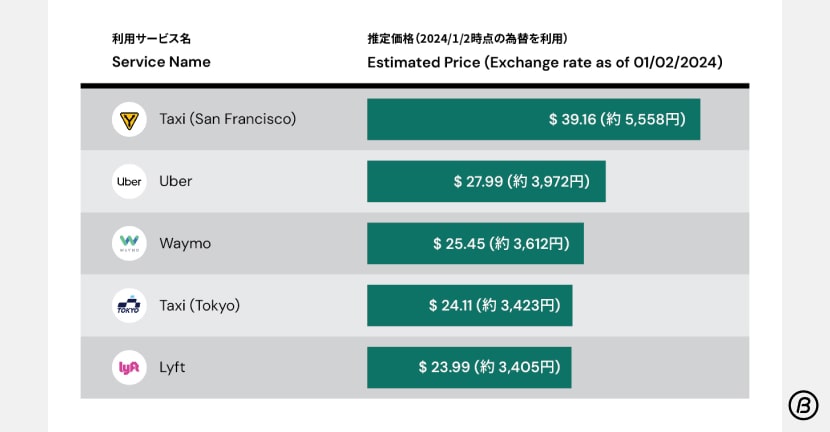
Price comparison of each service
Surprisingly, Waymo’s fare was found to be right in the middle of the range.
Waymo’s Innovation Continues
Waymo has been evolving rapidly and is now already in its 5th generation.
Analyzing information from over 20 million miles (32.18 million km) of automated driving on public roads over 10 years and more than 10 billion miles (16 billion km) of simulations, it is designed to tackle diverse and complex driving environments.
The following three are the latest technologies that make up the 5th generation.
Lidars: Located at the top of the vehicle, Lidars provide information across the entire 360-degree field of view with a range of over 300 meters. They render a 3D image of the surroundings and accurately measure the size and distance of objects around the vehicle.
Cameras: Long-range cameras that can identify important details such as pedestrians and stop signs at distances of over 500 meters + work in conjunction with the vehicle’s Perimeter Lidar system to accurately detect objects near the vehicle and help reduce blind spots.
Radars: Can instantly measure the speed of objects in severe weather conditions such as rain, fog, and snow, and can also see objects at a distance, such as detecting motorcyclists from hundreds of meters away.
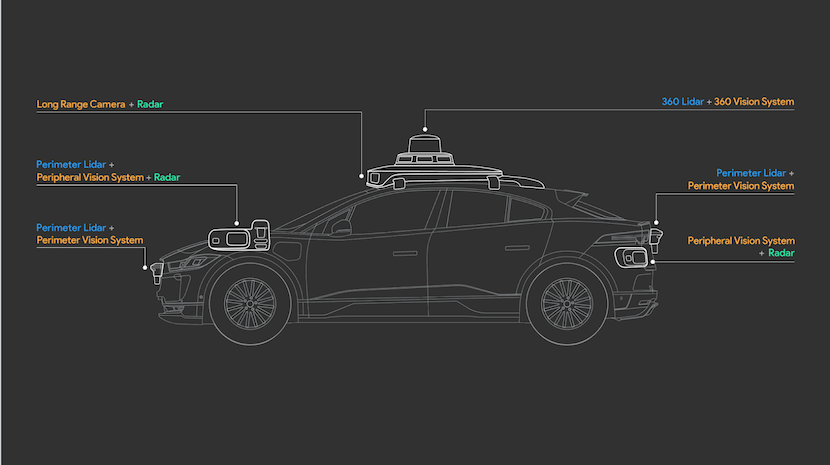
The various Waymo sensors
Conclusion
I was so impressed by the user experience of Waymo.
I think that this service is very much in line with the demands of people who use traditional taxis in Japan by being quick, convenient, private, peaceful, and more!
In addition to being cheaper than Uber and traditional taxi services, driverless taxis are peaceful and fun. This technology is already so impressive, that I look forward to seeing how it will evolve in the future.
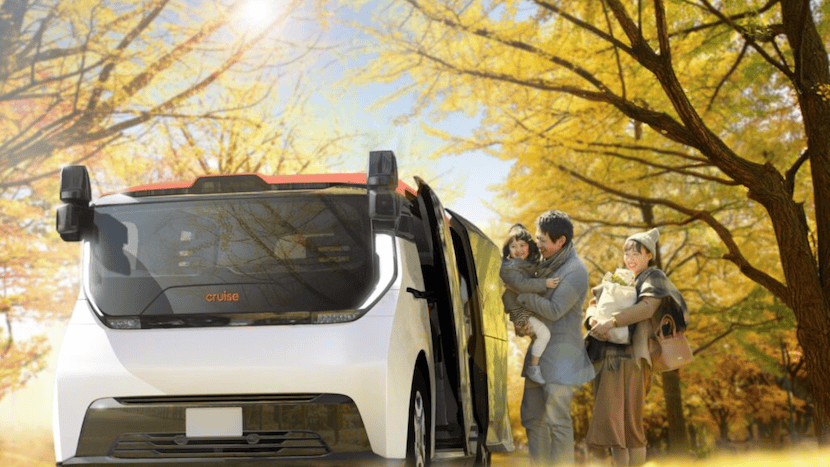
The “Cruise Origin” vehicle that Honda and Cruise are collaborating to launch in Tokyo in 2026
Cruise has already formed a joint venture with Honda and plans to commercialize self-driving cars in Tokyo and other parts of Japan by 2026.
Additional Comments
Finally, one of the questions regarding self-driving taxis is who is responsible in the event of an accident?
We sent the following questions directly to Cruise and Waymo’s customer support.
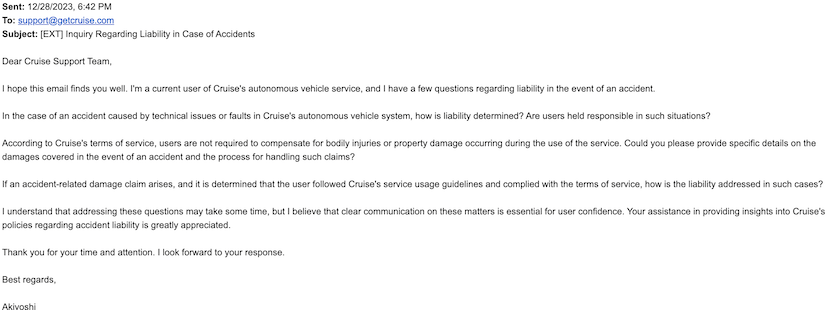
Actual email to Cruise
Then, I received the following message within a week.
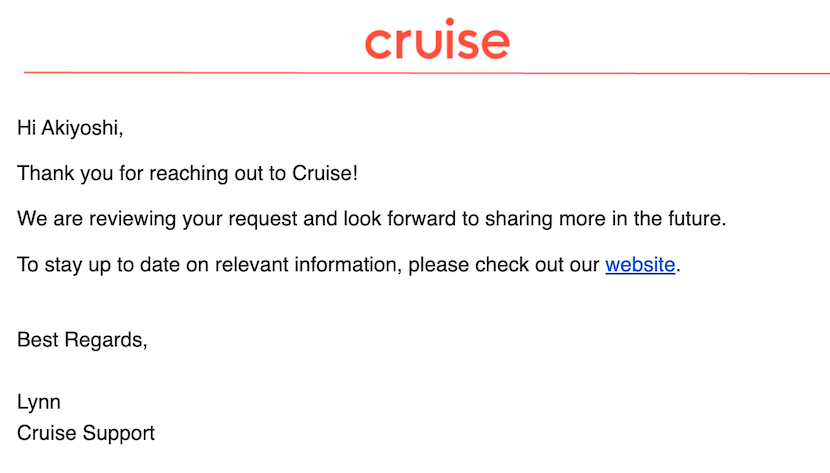
Reply from Cruise regarding my inquiry
As far as I can read their reply, unfortunately, I only received a vague response that they were looking forward to sharing more content in the future (Waymo still has not replied)
Perhaps this is because it is difficult to answer due to the legal risk of mentioning a specific event.
For your reference, the following are the terms of service for both Waymo and Cruise. The following are the Terms of Use for both Waymo and Cruise.
For reference, here is a video of the Chief Product Officer of Waymo discussing safety and other issues while riding in a Waymo.







